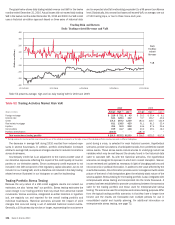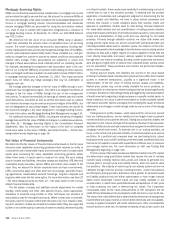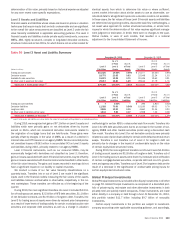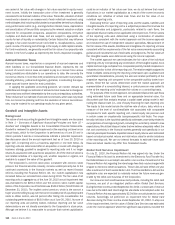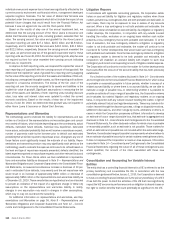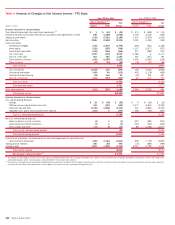Bank of America 2010 Annual Report Download - page 112
Download and view the complete annual report
Please find page 112 of the 2010 Bank of America annual report below. You can navigate through the pages in the report by either clicking on the pages listed below, or by using the keyword search tool below to find specific information within the annual report.We hedge our net investment in non-U.S. operations determined to have
functional currencies other than the U.S. dollar using forward foreign ex-
change contracts that typically settle in less than 180 days, cross-currency
basis swaps, foreign exchange options and foreign currency-denominated
debt. We recorded after-tax losses on derivatives and foreign currency-de-
nominated debt in accumulated OCI associated with net investment hedges
which were offset by gains on our net investments in consolidated non-U.S. en-
tities at December 31, 2010.
Mortgage Banking Risk Management
We originate, fund and service mortgage loans, which subject us to credit,
liquidity and interest rate risks, among others. We determine whether loans
will be held for investment or held-for-sale at the time of commitment and
manage credit and liquidity risks by selling or securitizing a portion of the loans
we originate.
Interest rate risk and market risk can be substantial in the mor tgage
business. Fluctuations in interest rates drive consumer demand for new
mortgages and the level of refinancing activity, which in turn, affects total
origination and service fee income. Typically, a decline in mortgage interest
rates will lead to an increase in mortgage originations and fees and a
decrease in the value of the MSRs driven by higher prepayment expectations.
Hedging the various sources of interest rate risk in mortgage banking is a
complex process that requires complex modeling and ongoing monitoring.
IRLCs and the related residential first mortgage LHFS are subject to interest
rate risk between the date of the IRLC and the date the loans are sold to the
secondary market. To hedge interest rate risk, we utilize forward loan sale
commitments and other derivative instruments including purchased options.
These instruments are used as economic hedges of IRLCs and residential
first mortgage LHFS. At December 31, 2010 and 2009, the notional amount
of derivatives economically hedging the IRLCs and residential first mortgage
LHFS was $129.0 billion and $161.4 billion.
MSRs are nonfinancial assets created when the underlying mortgage loan
is sold to investors and we retain the right to service the loan. We use certain
derivatives such as interest rate options, interest rate swaps, forward set-
tlement contracts, Eurodollar futures, as well as mortgage-backed and
U.S. Treasury securities as economic hedges of MSRs. The notional amounts
of the derivative contracts and other securities designated as economic
hedges of MSRs at December 31, 2010 were $1.6 trillion and $60.3 billion.
At December 31, 2009, the notional amounts of the derivative contracts and
other securities designated as economic hedges of MSRs were $1.3 trillion
and $67.6 billion. In 2010, we recorded gains in mortgage banking income of
$5.0 billion related to the change in fair value of these economic hedges
compared to losses of $3.8 billion for 2009. For additional information on
MSRs, see Note 25 – Mortgage Servicing Rights to the Consolidated Financial
Statements and for more information on mortgage banking income, see
Home Loans & Insurance beginning on page 45.
Compliance Risk Management
Compliance risk is the risk posed by the failure to manage regulatory, legal
and ethical issues that could result in monetary damages, losses or harm to
our reputation or image. The Seven Elements of a Compliance Program»
provides the framework for the compliance programs that are consistently
applied across the Corporation to manage compliance risk. This framework
includes a common approach to commitment and accountability, policies and
procedures, controls and supervision, monitoring and testing, regulatory
change management, education and awareness, and reporting.
We approach compliance risk management on an enterprise and line of
business level. The Operational and Compliance Risk Committee, which is a
sub-committee of the Operational Risk Committee, provides oversight of
significant compliance risk issues. Within Global Risk Management, Global
Compliance Risk Management develops and implements the strategies,
policies and practices for assessing and managing compliance risks across
the organization. Through education and communication efforts, a culture of
compliance is emphasized across the organization.
The lines of business are responsible for all the risks within the business
line, including compliance risks. Compliance risk executives monitor and test
business processes for compliance and escalate risks and issues needing
resolution.
Operational Risk Management
The Corporation defines operational risk as the risk of loss resulting from
inadequate or failed internal processes, people and systems or from external
events. Operational risk may occur anywhere in the Corporation, not solely in
operations functions, and its effects may extend beyond financial losses.
Operational risk includes legal risk. Successful operational risk management
is particularly important to diversified financial services companies because
of the nature, volume and complexity of the financial services business.
Global banking guidelines and country-specific requirements for managing
operational risk were established in a set of rules known as Basel II. Basel II
requires banks have internal operational risk management processes to
assess and measure operational risk exposure and to set aside appropriate
capital to address those exposures.
Under the Basel II Rules, an operational loss event is an event that results
in a loss and is associated with any of the following seven operational loss
event categories: internal fraud; external fraud; employment practices and
workplace safety; clients, products and business practices; damage to phys-
ical assets; business disruption and system failures; and execution, delivery
and process management. Specific examples of loss events include robber-
ies, credit card fraud, processing errors and physical losses from natural
disasters.
We approach operational risk management from two perspectives: (1) at
the enterprise level and (2) at the line of business and enterprise control
function levels. The enterprise level refers to risk across all of the Corporation.
The line of business level includes risk in all of the revenue producing
businesses. Enterprise control functions refer to the business units that
support the Corporation’s business operations.
The Operational Risk Committee oversees and approves the Corporation’s
policies and processes to assure sound operational and compliance risk
management and serves as an escalation point for critical operational risk
and compliance matters within the Corporation. The Operational Risk Com-
mittee reports to the Enterprise Risk Committee of the Board regarding
operational risk activities. Within the Global Risk Management organization,
the Corporate Operational Risk team develops and guides the strategies,
policies, practices, controls and monitoring tools for assessing and managing
operational risks across the organization as well reporting results to gover-
nance committees and the Board.
The lines of business and enterprise control functions are responsible for
all the risks within the business line, including operational risks. In addition to
enterprise risk management tools like loss reporting, scenario analysis and
risk and control self-assessments, operational risk executives, working in
conjunction with senior line of business executives, have developed key tools
to help identify, measure, mitigate and monitor risk in each line of business
and enterprise control function. Examples of these include personnel man-
agement practices, data reconciliation processes, fraud management units,
transaction processing monitoring and analysis, business recovery planning
and new product introduction processes. The lines of business and enterprise
control functions are also responsible for consistently implementing and
monitoring adherence to corporate practices. Line of business and enterprise
control function management uses the enterprise risk and control self-as-
sessment process to identify and evaluate the status of risk and control
110 Bank of America 2010








